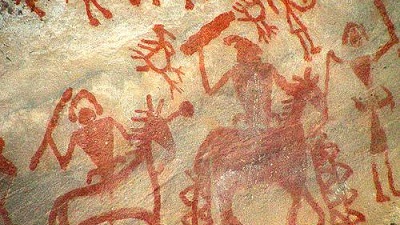Joel Elgin. Influences: The Art of India
Welcome back.
Still thinking about Cultural Appropriation? Good, here’s a challenge. To really understand how much appropriation is out there why don’t you put your computer/phone away (after reading this of course) and go on a scavenger hunt.
First step is you have to enter “sleuth’ mode. Wander your world with your phone/camera. When you spot an object that sports an “appropriated” image, snap a photo of it. Jot down what the object is and why you think it was appropriated and from what culture it was taken.
Warning: Be sleuthy but also respectful. Many people lack your level of SUAVENESS. They aren’t aware of the issue of “appropriation”. Your job here is to know how much appropriation is out there in the commercial world and thus discover your own visual definition of the term, not to preach.
If you photo your Aunt Amelia’s native American motif lampshades and call her out you could bring her to tears; you could be banned from all future family gatherings. One poor past student of mine accepted this challenge and shot a photo of a woman’s bikini that was decorated with a tribal design and poor Kadie ended up in the bottom of the pool when the woman objected to the candid photo. Another was escorted from Pier 1 and sadly, Allie is banned from ever entering the store again.
So be careful and respectful. I’m guessing you could start with your own possessions? You might have once spent a few bucks on something appropriated for profit from another culture before you became the suave person you are today.
The Art of India
To make our understanding of Indian art… more understandable,
understand that the artwork can be classified into specific periods each
reflecting particular religious, political and cultural developments.
Understand?
Most important thing to know though is the
influence of religion. India is the birthplace of Buddhism and Hinduism and the
artwork was created to spread the teachings, the religious beliefs.
Ancient India Art
Buddhist Art
Hindu Art
Islamic
Ancient India Art
The earliest examples of art in India are
petroglyphs.
Bhimbetka rock painting, Madhya Pradesh, India
(c. 30,000 years old)
Harappan
Harappan's are the name given to any of the
ancient people belonging to the Indus Valley civilization between 2600-1900
B.C.
The Harappan seals were fired clay most
likely used for trade. The bull that commonly appears on the seals might have
been associated with fertility cults.
Another possible ancient fertility cult object
is the :
Dancing Girl
C. 2500 B.C.
Place of Origin: Mohenjodaro
Materials: Bronze
Dimensions: 10.5 x 5 x 2.5 cm.
Acc. No. 5721/195
The VEDIC period between period 1750 – 1500
BCE was a time when very little art was made but what was made, did influence
future artwork. Key to the influence was the development of Dharma, a
worldview or cosmic law that governed nature, human society and the
supernatural world. Dharma and Samsara, the idea of endless rebirths
will eventually lead to images that spread the word of the Buddha and the next
stage of Indian Art, Buddhist Art.
Buddhist Art
Buddha, the Enlightened One, following six
years of meditation, came to the realization that people could cease suffering
by following eight steps of self discipline and virtuous behavior.
Sacred sights and architecture such as the
Buddhist Temple at Karli, are considered the original Buddhist artworks.
Buddhist Temple at Karli
Carved into the interior of the temple were
figurative images:
Mithuna: Buddhist relief
No images of Buddha were created until the
First century CE.
The depiction of the Buddha had a number of
consistent features.
1.) Frontal position
2.) Stationary pose
3.) When seated, assumes the lotus position (padmasana)
The hand positions/ gestures are symbolic
mudras, reflecting a state of spiritual consciousness.
1.) dharmacharka – teaching mudra – thumb and
index finger joined creating the Wheel of Law.
2.) abhaya – reassurance mudra – right hand,
palm extended at shoulder height.
3.) dhyana – meditation mudra – both hands
resting on the thighs, palms up, thumb tips touching.
4.) varada – gift bestowing mudra – left palm
out with fingers pointing down.
(Note – stay tuned for a number of
images of Buddha in the coming posts that illustrate the body and hand
positions)
Unlike many of the African sculptures, the
Indian Buddha is not depicted wearing jewelry. He has renounced the material
world. The Buddha does often have a spot on his forehead known as a urna. And
a stylized shape on the top of his head, hair, known as ushnisha.
Seated Kapardin Buddha from Katra Mound
Bodhisattvas
Are Buddha like, or nearly Buddhas. They are
enlightened beings who have remained on earth to help weaker people achieve
enlightenment. The difference is that the Bodhisattvas are often depicted with more
elaborate costumes and possessions, including a flask. It holds the elixir of
life.
Bodhisattva statue at National Museum, New Delhi
The Gupta style,
Buddha imagery morphed through the Mathuran
and Gandharan styles to the Gupta style during the Kushan Dynasty (50 -320).
Rom 319 to 500, Golden Age of Indian art occurred during the reign of the Gupta
Kings. The carving was refined, and the setting included with the Buddha became
more detailed and elaborate.
Buddha sermon in Deer park
The Gupta Kings were Hindu and their beliefs
reduced the power of the Buddhist religion.
Sorry, times up and that's enough India for
one day - stay tuned for more and thanks for reading.








